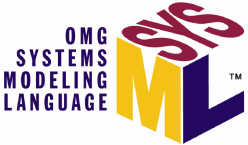.png?width=150&height=150&name=diagram%20(5).png)
The Ultimate Guide to Model-Based Systems Engineering
Unravel the answer to the most pressing question - What Is MBSE? with our ultimate guide.

What Is MBSE?
Model-Based Systems Engineering (MBSE) is a methodology that uses models to represent and analyze complex systems. This approach aids in the development of systems from concept to operation. It does this by using models to capture the system's requirements, design, behavior, cost, risk, and other aspects.
This article discusses Model-Based Systems Engineering (MBSE) in more detail. We will look at the advantages of MBSE, the MBSE process, and the tools used for MBSE. We will also discuss some of the challenges associated with MBSE, and how to overcome them.
The Benefits of MBSE
Curious about what model-based systems engineering is and why it's becoming increasingly popular? MBSE provides numerous advantages over traditional systems engineering approaches, including improved communication, enhanced collaboration, increased efficiency, and better overall system quality.
INCREASED EFFICIENCY
MBSE also provides increased efficiency. Model-Based Systems Engineering (MBSE) streamlines systems engineering tasks like documentation and validation. This reduces the time and effort needed to finish these tasks. This allows engineers to focus on more complex tasks, such as system design and analysis.
By using models to represent the system, engineers can quickly and easily identify potential issues and areas for improvement. This prevents delays and cost overruns. It also ensures that the system is created quickly and efficiently.

Source: AWS
Improved Communication
One of the primary benefits of MBSE is improved communication. MBSE uses graphical models that are easier to understand and communicate, allowing stakeholders to better understand the system and its requirements. This is particularly important in complex systems, where there are many different stakeholders with different backgrounds and levels of expertise.
Models can be used to represent the system. This enables stakeholders to understand how the system is intended to function. They can then provide feedback on the design. This feedback can be reused in the model, which helps to ensure that the system meets stakeholders' needs.
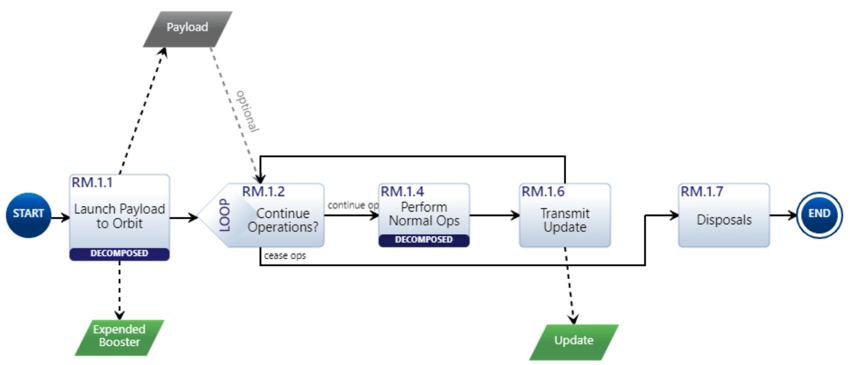
Note: The diagram above illustrates the process of launching a payload into orbit, presented in an easy-to-understand format for all stakeholders. The action diagram was specifically designed to promote clarity and understanding amongst a diverse range of stakeholders with varying degrees of technical expertise.
Enhanced Collaboration
Another benefit of MBSE is enhanced collaboration. MBSE enables multiple stakeholders to work on the same model, which promotes collaboration and reduces the risk of miscommunication. This is important in large, complex systems. There can be many teams working on different parts of the system.
Teams can collaborate more efficiently with a shared model. This ensures their work is in sync with other teams. This helps reduce errors and inconsistent data. It also ensures the system is developed in an efficient and coordinated way.
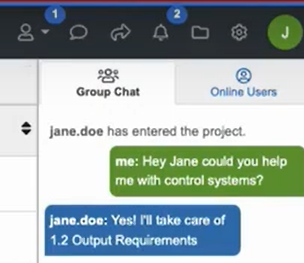
Tip: Innoslate, MBSE software, has built-in collaboration tools such as real-time shared views of the model, chat, comments, and permissions.
Better Quality
Finally, MBSE improves overall system quality. MBSE helps to identify and resolve issues early in the development process, which improves the quality of the final product. By using models to represent the system, engineers can more easily identify potential issues and areas for improvement.
Engineers identify and fix problems early in the development process. This ensures that the product meets everyone's needs. It also ensures the product is of the highest quality.
The MBSE Process
The MBSE process typically involves the following steps:
Step 1. Requirements Management and Analysis
In this step, the system requirements are defined and captured in a model. This involves identifying the needs of all stakeholders and developing a set of requirements that meet those needs. You may need requirements management software to help you with requirements gathering and managing the requirements.
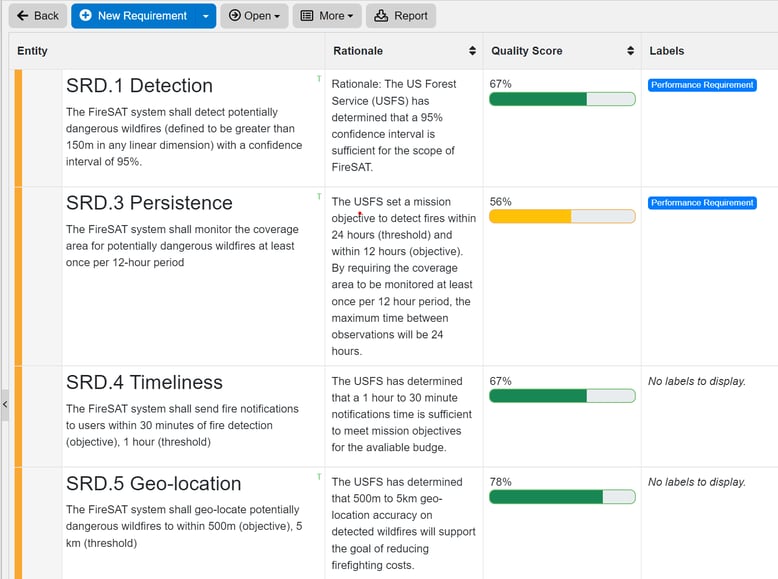
MBSE tools with built-in requirements management views create a separate data entity for each requirement so that each requirement can be traced to any entity in the database, such as cost, time, tasks, resources, etc.
Read more about how Requirements Management and MBSE can work together.
Step 2. System Design
The system design is developed based on the requirements model, and captured in a separate model. This involves developing a design that meets the requirements, and that is efficient, reliable, and cost-effective.
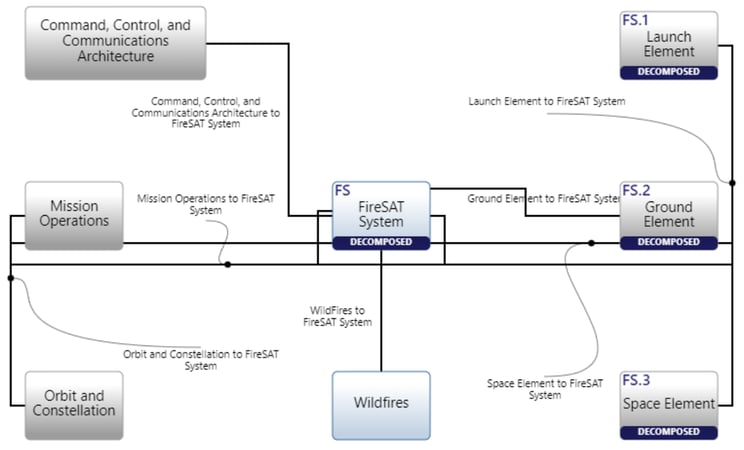
Step 3. Behavioral Modeling
The behavior of the system is modeled to capture how it will function under different conditions. Develop a model to capture the behavior of the system and develop a user story. This model can be used to simulate the system in different conditions.

Step 4. Risk analysis
It involves identifying and assessing potential risks that may be associated with the system being developed or operated. Risks can be associated with technical issues, scheduling, cost, performance, safety, and other areas. These could potentially affect the success of the system's development or operation. By conducting a thorough risk analysis, engineers can take proactive measures to mitigate these risks and ensure the system's success.
Step 5. Validation and Verification
The models are validated and verified to ensure that they accurately represent the system and meet the requirements. This involves testing the models to ensure that they are accurate, reliable, and consistent with the requirements.
Here is an example of verification and validation validating process models and requirements in a system:
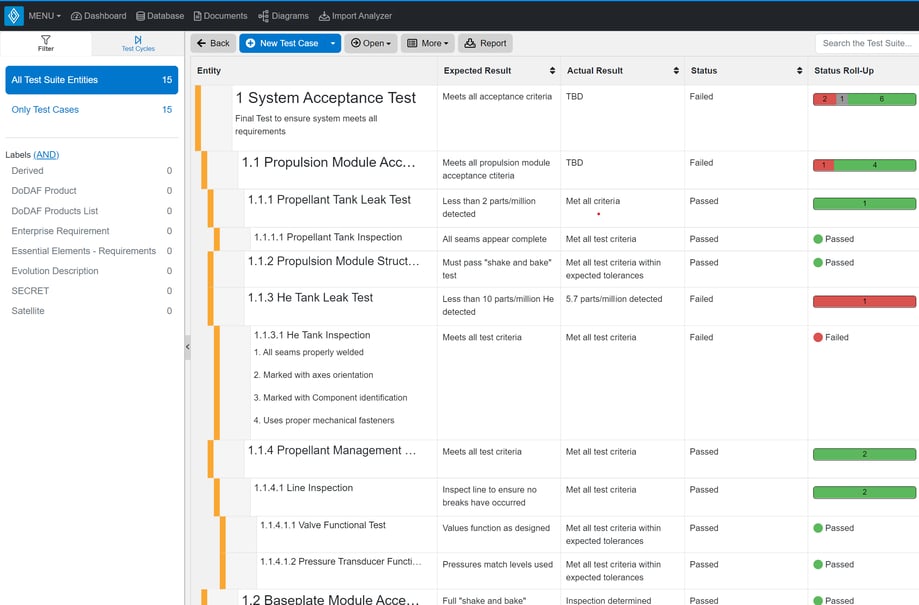
Step 6. Implementation
The system is implemented based on the models, and the models are updated to reflect any changes made during implementation. This involves building the system based on the models, and ensuring that the system meets the requirements.
Step 7. Operation and Maintenance
The system is operated and maintained, and the models are updated to reflect any changes made during this phase. This entails guaranteeing the proper functioning of the system and promptly and efficiently resolving any encountered issues.
Model-Based Systems Engineering offers a wide range of applications that go beyond the seven steps mentioned, encompassing fault-tree analysis and FMEA, among others.
Having experienced program managers overseeing the entire project is crucial throughout the seven steps of the MBSE process.
Program Management
Program management in systems engineering is a critical discipline that focuses on coordinating and overseeing the successful execution of complex projects within an organization. It plays a pivotal role in ensuring that multiple interconnected projects, often referred to as a program, are effectively planned, executed, and delivered to meet specific goals and objectives.
This involves aligning the efforts of cross-functional teams, managing interdependencies among different projects, and maintaining a holistic view of the entire program's objectives. A program manager in systems engineering typically needs to navigate through technical challenges, budget constraints, and time constraints to ensure the successful delivery of the overall system.
Program managers have access to a variety of valuable tools that can aid in the successful execution of complex projects. These tools include Gantt charts, Kanban boards, tasking/calendars, and process models. By utilizing these resources, program managers can effectively manage interdependencies, navigate technical challenges, and stay on track with budget and time constraints.
Tip: Innoslate integrates cost, schedule, and performance into the lifecycle, making it an essential tool for program managers overseeing a system.
Program Management in Model-Based Systems Engineering
Learn how to perform PM in Innoslate such as viewing important upcoming dates and deadlines, developing simulatable Gantt Charts, tracking Kanban Board progress, view Work Breakdown Structures, and more
Watch Now
MBSE Methods
There are several systems engineering approaches that can be used to support MBSE. Some of the most popular systems engineering approaches include:
Agile Systems Engineering
Agile Systems Engineering is an approach to systems engineering. It is based on the principles of agile software development. It emphasizes collaboration, flexibility, and rapid iteration, and is designed to support the development of complex systems in rapidly changing environments. SPEC Innovations’ developed an approach to efficiently facilitate Agile Systems Engineering, called the Middle-Out approach.
- Work is done in short cycles (often called sprints) with regular feedback and adaptation.
- Suitable for projects where requirements may evolve over time.
- Emphasizes ongoing collaboration among team members and stakeholders.
- Testing and changes can occur throughout the project lifecycle.
- Outcomes are reviewed regularly to ensure alignment and quality.
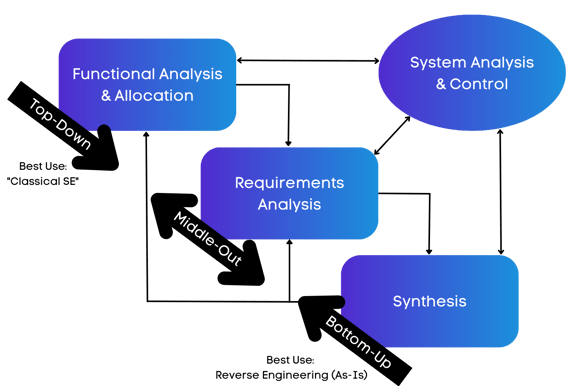
MOSA
The Modular Open Systems Approach (MOSA) is a systems engineering approach that is designed to support the development of complex systems. MOSA emphasizes the use of modular, open, and standardized components and interfaces, which can be easily integrated and updated as needed.
Systems of Systems Engineering
Systems of Systems Engineering is an approach to systems engineering. It is designed to support the development of complex systems. These systems are composed of multiple subsystems. It emphasizes the need to consider the interactions and dependencies between subsystems, and to ensure that all subsystems are properly integrated.
V-Model Approach
The V-Model is an extension of the waterfall model. It adds a testing phase for each corresponding development stage, which helps ensure quality.
Unlike the waterfall model, the V-Model puts a strong focus on the user. Users are involved in all stages of the development cycle. This helps guarantee the final product satisfies their needs and expectations.
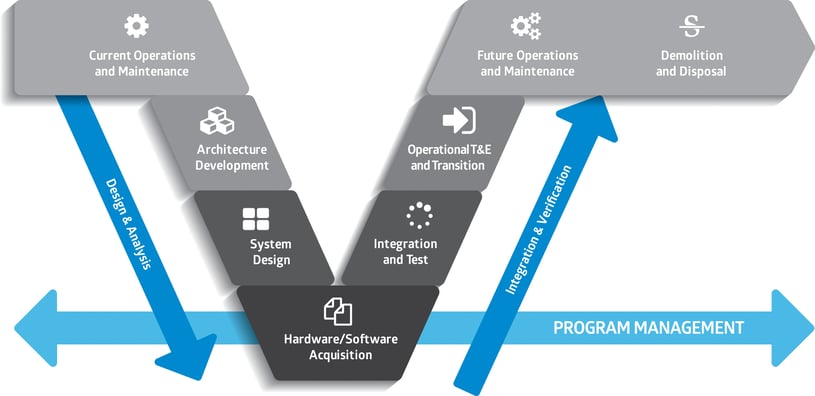
Waterfall Approach
The waterfall approach in systems engineering is a linear, sequential development process where each phase must be completed before the next one begins. It’s one of the traditional methods used in both software and systems engineering, particularly in projects where requirements are well understood and unlikely to change.
- Projects follow a strict sequence: requirement gathering, design, implementation, testing, and maintenance.
- Each phase must be finished before the next begins, making it difficult to go back and change things.
- Works best when project requirements are well-defined and changes are unlikely.
- Testing typically occurs only after the build phase.
- Provides a clear plan and timeline, but is less responsive to change.
- For most dynamic, rapidly changing projects, Agile is preferred. For projects with predictable, stable requirements, Waterfall remains suitable.
Can't decide on Agile or the Waterfall Method?
A recent Naval Postgraduate School study found that using Innoslate with Agile practices cut delivery time by more than 50%—without sacrificing safety or compliance.
Modeling Language Standards
There are a number of modeling languages available for MBSE, including:
SysML
SysML is a versatile modeling language that facilitates the specification, analysis, design, and verification of complex systems. It employs a graphical notation to represent system requirements, structure, behavior, and other aspects, and consists of nine diagrams to convey different aspects of the system. The nine diagrams are:
- Requirement diagram
- Block Definition Diagram
- Internal Block Diagram
- Parametric Diagram
- Package Diagram
- Activity Diagram
- Sequence Diagram
- State Machine Diagram
- Use Case Diagram
As an extension of the Unified Modeling Language (UML), SysML was developed to cater to the unique needs of system engineering. It is utilized to capture the requirements, design, and behavior of complex systems, and enhances collaboration and comprehension of system designs among stakeholders by communicating system requirements, structure, behavior, and constraints. SysML empowers system engineers to work collaboratively and efficiently while ensuring that all stakeholders' needs are met.
.png?width=439&height=144&name=Landscape_Orange%20(1).png)
LML
Lifecycle Modeling Language is an ontology-based language with limited diagrams specified. It is designed to meet the needs of all stakeholders throughout the system life cycle. It is a complete solution. It encompasses SysML and other modeling languages.
LML offers several advantages over other modeling languages. One of them is the use of a single language for stakeholders to discuss the system's lifecycle. Ensuring everyone involved in the development and operation of the system understands the different stages of the lifecycle is beneficial. This helps everyone work together more effectively, optimizing the system's design and performance.
LML employs the ERA (Entity, Relationship, Attribute) approach, commonly utilized to define database schemas, but enhances it by incorporating attributes to relationships. This extension reduces the number of relationships required, similar to how attributes reduce the number of entities needed. LML requires only three diagram types:
LML models can be used to simulate the system's behavior under different conditions. This can help identify potential issues and optimize performance.
Related Article: Drawings Do Not Equal Models: What Is Real MBSE?
MBSE Tools and Technologies
Model-Based Systems Engineering (MBSE) relies on various tools to create, analyze, and manage models effectively. These tools enable teams to improve collaboration, automate workflows, and ensure accuracy in system design. The right MBSE tool should support SysML, requirements traceability, simulation, and integration with PLM and CAD systems.
Model-Based Systems Engineering (MBSE) relies on specialized tools to efficiently create, analyze, and manage complex system models. These tools provide:
- System Modeling & Visualization – Graphical and textual representations using SysML, UML, or custom frameworks.
- Requirements Traceability – Linking models to requirements, ensuring verification & validation.
- Collaboration & Integration – Support for cloud-based collaboration and integration with PLM, CAD, and simulation tools.
- AI & Automation – Emerging AI-driven capabilities to enhance model analysis and decision-making.
Selecting the right MBSE tool depends on your engineering discipline, compliance needs, and workflow requirements.
🔗 Want a detailed comparison of what tools are available for MBSE? Check out our comprehensive guide:
👉 MBSE Tools for Systems Engineers?
9 Features of a Great MBSE Tool
This guide will help you discover the right model-based systems engineering solution for you and your team.
Read Guide
Industries Using MBSE
Transportation
Transportation systems, whether they are subway networks, highways, or air traffic control systems, are complex entities that require meticulous planning, design, and management. Model-Based Systems Engineering offers a holistic approach to address the multifaceted challenges of transportation, ensuring safety, efficiency, and reliability.
Aerospace and Defense
Systems engineering is critical in developing aircraft, spacecraft, missiles, and defense systems. Its primary objective is to guarantee that intricate aerospace projects meet stringent requirements for performance, safety, and reliability.
Information Technology
In the IT industry, systems engineering helps design, implement, and manage large-scale software and hardware systems. It ensures that IT solutions align with business objectives and meet user requirements.
Healthcare
Systems engineering is increasingly being applied in healthcare to improve the efficiency and effectiveness of healthcare delivery systems, medical devices, and health information systems.
Energy and Utilities
Systems engineering plays a vital role in designing and optimizing energy production, distribution, and management systems, including renewable energy systems, smart grids, and energy storage solutions.
Manufacturing
In manufacturing industries, systems engineering helps optimize production processes, improve product quality, and ensure efficient resource utilization.
Telecommunications
Systems engineering is essential in designing, developing, and managing telecommunications networks and services, ensuring reliable and scalable communication solutions.
Automotive
Systems engineering is used in the automotive industry to design and integrate complex automotive systems, including vehicle electronics, safety systems, and advanced driver-assistance systems (ADAS).
Infrastructure and Construction
Systems engineering is applied in the planning, designing, and managing of infrastructure projects, such as bridges, tunnels, highways, and water supply systems, ensuring their safety, reliability, and sustainability.
Discover how the US Navy's innovative MBSE strategies are safeguarding our infrastructure, preventing catastrophes like bridge failures, and more.
Financial Services
In the financial services industry, systems engineering helps design and optimize financial systems, including trading platforms, risk management systems, and transaction processing systems.
Environmental Engineering
Systems engineering addresses environmental challenges by designing and implementing systems for environmental monitoring, pollution control, and sustainable resource management.
These examples only scratch the surface of how systems engineering continually expands as industries become more intricate and interconnected. The fundamental principles of systems engineering render it an invaluable discipline for various sectors, including a comprehensive approach, interdisciplinary collaboration, and a focus on optimizing systems.
Challenges Associated with MBSE
While MBSE offers many benefits, it also presents certain challenges that organizations must address to ensure successful implementation. Understanding current MBSE trends can help in navigating these challenges effectively. These challenges include:
Complexity
One of the primary challenges associated with MBSE is complexity. MBSE is often used in complex systems, which can be difficult to model and analyze. This can lead to models that are difficult to understand and use, and that may not accurately represent the system.
It is important to develop models that are simple yet capture all necessary information in order to overcome this challenge. It is important to use modeling languages and tools designed for complex systems. These tools should be able to manage the complexity of the system being modeled.
Integration
Another challenge associated with MBSE is integration. MBSE often involves multiple models that must be integrated to form a complete system model. This can be difficult to accomplish, particularly when the models are developed by different teams using different tools and languages.
Also, integrating MBSE tools plays a crucial role in facilitating digital engineering efforts. It is important to tackle this challenge. Establishing clear guidelines for model integration is necessary.
Additionally, using tools and languages that are compatible with each other is essential. It is essential to create a shared language and symbols for the models. This will make it easier to integrate them.
Tip: Innoslate’s Import Analyzer imports from many different MBSE tools and Microsoft Office solutions. The Rest APIs can take integration even further.
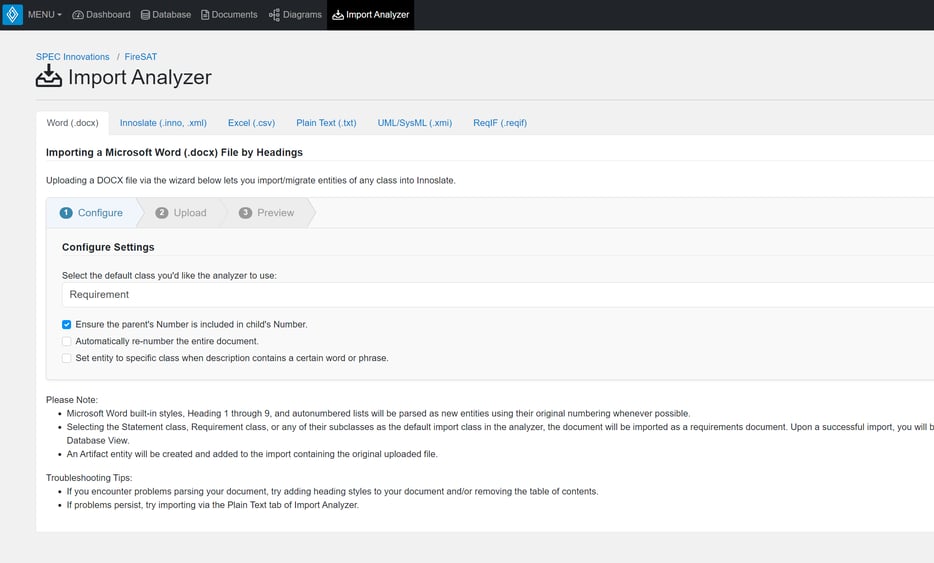
Verification and Validation
Finally, MBSE can be challenging when it comes to verification and validation. MBSE relies on models to visualize the system. This can make it hard to check if the system meets the requirements. Verifying and validating the system are complicated tasks.
Establishing clear guidelines for model verification and validation is key to overcoming this challenge. Utilizing tools and techniques specifically designed for MBSE is also important.
It is essential to involve all stakeholders in the verification and validation process. This ensures that the system meets the requirements of all stakeholders. Using a collaborative MBSE tool and a modeling language that encompasses the full lifecycle will reduce this issue.
How to Get Started With MBSE In Your Organization
Implementing MBSE into an organization requires a strategic approach that involves several key steps. It is important to identify specific goals and objectives that MBSE is intended to achieve. Examples include:
- reducing development time
- increasing collaboration among team members
- improving system performance
Next, the organization should assess its current capabilities and identify any gaps that need to be addressed to successfully implement MBSE. This may involve investing in new tools or technologies or providing training and development opportunities for team members.
Once the organization has a clear understanding of its goals and capabilities, it can begin to develop a plan for implementing MBSE. This may involve identifying specific projects or initiatives that will use MBSE, establishing standards and guidelines for modeling and simulation, and developing processes for managing and sharing models across teams and departments.
It is important to set up metrics and performance indicators. These can be used to measure the success of MBSE implementation. They can also help to identify areas for improvement.
It is worth noting that most MBSE tools are customizable, providing a flexible framework to better suit your project requirements. For instance, Innoslate has a schema extension feature that enables modification of its ontology. Once you make the necessary adjustments, it is crucial to document them, and Innoslate can help you create this documentation. This documentation is what we refer to as the “Data Management Plan” which ensures that you get the desired output from the tool.
Finally, the successful implementation of MBSE requires a culture of collaboration and continuous improvement. Establish cross-functional teams to develop and test models. Invite stakeholders to give feedback and input. Review and update processes and procedures regularly. This will ensure they remain effective.
With the right approach and commitment, implementing MBSE can help organizations improve the quality and efficiency of their systems engineering processes and to achieve their strategic objectives.
Watch Recorded Webinar
Getting Started with MBSE
Discover how to effectively implement model-based systems engineering across your organization or project by gaining a comprehensive understanding of the lifecycle process. Explore the top-down, bottom-up, and middle-out approaches to streamline your MBSE efforts.
Watch Webinar
Getting Started with MBSE
Getting Started with MBSE

.png?width=600&height=338&name=Copy%20of%20The%20Ultimate%20Guide%20to%20MBSE%20(2).png)
Optimize Your MBSE Efforts
Begin your journey to optimized MBSE with Innoslate's powerful model-based systems engineering and requirements management solutions. Sign up for a free account today and experience the difference.



